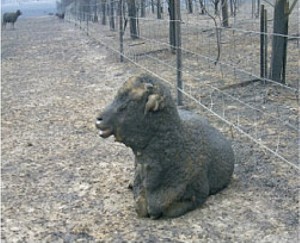by Cecil Poole
I lived and farmed in Southern Australia (Western Victoria) for the driest decade since rainfall records were first kept (1870’s). Southern Australia is reputedly one of the most fire prone areas in the world, with periodic wildfires of extreme severity. My story is not one of extremes.
A smallish grass fire broke out one afternoon on a neighbouring property, burning a narrow strip of land in a southerly direction, fanned by a strong northerly. Thus far typical of grass fires in the region. Fortunately when the expected westerly change came late in the day the eastern flank of the fire had been reasonably well contained and the fire controlled.  From memory the fire destroyed some fencing and perhaps a thousand sheep had to be destroyed as they had severe burns to legs, hooves, lips, noses and eyebrows. I was part of a team euthenasing these sheep, and a distressing task it was.
From memory the fire destroyed some fencing and perhaps a thousand sheep had to be destroyed as they had severe burns to legs, hooves, lips, noses and eyebrows. I was part of a team euthenasing these sheep, and a distressing task it was.
An interesting part to this fire is how it started. The fire itself occurred in late summer. The previous spring a neighbouring landholder had burnt the debris from a fallen tree, the debris having been stacked on top of the stump, in order to burn it also. The heap of debris and the stump had burnt well, over a period of a few days. Each morning the farmer would start his front end loader and push the heap together again, each time pushing it up over the stump. Each time he pushed a little soil was also laid over the stump and more importantly the roots. This soil layer largely excluded oxygen from the roots and the base of the stump, damping the fire almost, and I say almost advisedly, completely. The farmer left the heap when he felt the job was done. Unfortunately he was not to know what was going on underground. For days, then weeks, then months the roots and stump base smoldered away underground, very slowly, imperceptibly. As summer replaced spring so to the soil started to dry out, soil particles shrank, air replaced the moisture. The smoldering continued. Then after some three or four months the smoldering – very slow burning – of the roots reached the surface. The north wind would have blown away some of the covering soil, and fanned the smoldering root into red hot coals. From there dry leaves, bark or grass, probably blown by the wind caught fire on the roots then were blown to nearby taller dry grass – and the fire was away.
Now why would a story like this be of interest to Passive Complicity? Purely because of the debate about ‘giving oxygen’ to those with repressive (and repulsive) dogmas – the Pauline Hansens, the Corey Bernardis, the Christopher Pynes, the David Irvings of this world. Many believe that ‘giving oxygen to these people and their views in a sense publicises and legitimises them. Professor Denis Altman of LaTrobe University argued that discussing Bernardi’s views helped promote his views and increased sales of his book. Others such as Phil Cleary would argue that views such as those need to be vociferously denounced for what they are, that by doing this denouncing provides tools and armament for those normally passively complicit to fight back in bars, at barbecues, at sporting events and in every social situation. These views should never go unchallenged ‘through to the keeper’.
Passive Complicity would like to add to the sum of oxygen in order to complete the burn, to stop the smoldering and to provide a better start. We see this as fundamental in all cases of sexism, racism, prejudice and injustice. This is not a conversation, this is a duty for every member of a free and just society.
